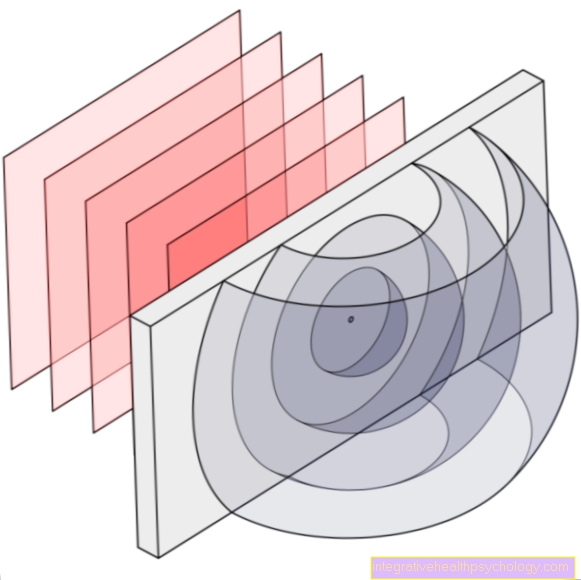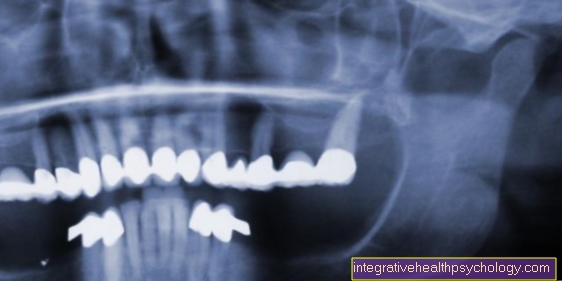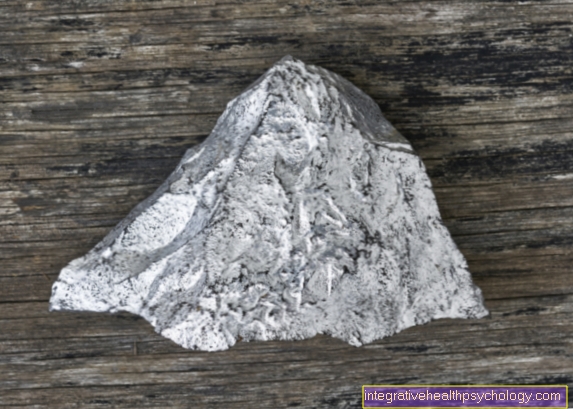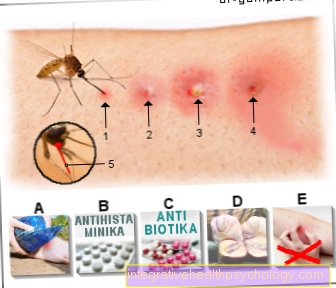Gas fire
What is a gas fire?
A gas burn is a bacterial infection of the soft tissue that is life-threatening. In the majority of cases, the pathogen is called Clostridium perfringenswhich is why the disease is also known as clostridial myonecrosis.
What is special about this form of infection is that the bacteria quickly drive the affected tissue to death. The bacteria also generate gases, so that a special crackling sound can be heard when the wound is felt. This also explains the naming “gas fire”. The infection can spread very quickly and then pass on toxins, i.e. poisons from the bacteria, into the bloodstream. Then vital organs are endangered within a short time.

Causes of the gas fire
The gas fire is mostly triggered by the bacterium Clostridium Perfringens and is found in wounds that the pathogen has entered. For example, deep bruises, stab wounds or war injuries can lead to infection with the germ.
Wounds that have little air and are poorly supplied with blood are particularly affected. As a result, diseases such as arteriosclerosis or diabetes mellitus, which can reduce the blood flow in the body, become risk factors.
The germ itself can be found in many different places, such as in the soil or in the human intestine. A wound can be infected from the outside by the contamination or it can reach other parts of the body from the human intestinal tract.
The latter is only the case when the immune system of a person is weakened by other diseases. The bacterium can produce various toxins, which can then cause life-threatening damage to other organs via the bloodstream.
diagnosis
It is especially important that the diagnosis of the gas fire is made very quickly. In just a few hours, the patient can get into a life-threatening situation. Particularly noticeable and characteristic of the infection with the gas fire is the extremely rapid spread, the strong swelling of the surrounding tissue and the crackling of the skin when the wound is palpated.
A smear of the wound can be used to examine under the microscope whether the type of bacteria can be recognized. In addition, the gas formation can be seen in an X-ray examination in the affected part of the body.
frequency
Fortunately, the frequency of gas fires is not very high. Around 100 cases are reported in Germany each year. In comparison, around 1,000 cases of the disease in the USA. However, the mortality rate is 50%.
A much more common occurrence of infection with the gas fire pathogen was recorded in the First World War. According to estimates, well over 100,000 German soldiers died from the infection at the time.
I recognize a gas fire by these symptoms
The gas fire is primarily recognized by the characteristic clinical symptoms and then the diagnosis can be confirmed by laboratory tests and X-rays. The gas formation that takes place by the bacterium is very characteristic of the infection.
The affected wound is extremely painful and may give off a foul odor. The soft tissue around the wound can develop edema, i.e. a strong swelling with water deposits in the tissue.
The skin is often blue-purple in color. These are all the symptoms that affect the affected wound and surrounding tissue. If the bacterium then releases a toxin, i.e. a substance that is poisonous for humans, symptoms can also occur that affect the whole body or other regions.
If the toxin gets into the brain or the kidneys, for example, life-threatening changes in the body's circulation can occur. This can be noticeable, among other things, by signs of shock, i.e. a drop in blood pressure and an increase in heart rate (see also: Palpitations).
Read more about the signs of shock in the following article: Symptoms of shock
therapy
Ideally, the gas fire is diagnosed quickly based on the typical clinical signs so that therapy can be started as early as possible. But since every minute counts, in many cases the treatment must be carried out on suspicion.
Surgical therapy is the priority. To do this, the infected, dead tissue is surgically removed. Extensive cleaning is also necessary. In some cases, the body part must also be amputated. In this way you want to prevent the further spread of the germ.
Antibiotic therapy must also be started at the same time. In many cases there are also infections with other bacteria, so that several different antibiotics are given.
Monitoring of the patient in the intensive care unit with sufficient fluid intake supports the circulation. Unfortunately, despite the therapy, every second person dies from the infection. The dangerous aspect of a gas fire is that the infection spreads rapidly and can lead to death between a few hours and days.
Pressure chamber
The gas fire-causing bacterium can only grow if there is no oxygen. So especially in the ground, in deep wounds and tissues with poor circulation. In a pressure chamber an extremely high oxygen pressure can be achieved with overpressure, so that the bacteria die.
Unfortunately, the problem here is often that the patients are not stable enough to be transported into such a chamber. To make matters worse, pressure chambers are not available everywhere in Germany.
You may also be interested in the following article: Hyperbaric Oxygen Therapy
Can you vaccinate against gas fire?
In the majority of cases, the gas fire is triggered by the bacterium Clostridium perfringens. But other germs can also be responsible for this dangerous clinical picture. Vaccination for humans is currently not approved.
However, there is a vaccine for animals that can also be infected. In this case, a weakened form of the toxin released by the bacteria is injected into the animal's body. In this way, the immune system can recognize the toxin and be trained to fight off the penetrating substances.
Fortunately, the incidence of the disease is extremely rare, so vaccination may not be appropriate.
forecast
Unfortunately, the prognosis for the gas fire is very bad. Without surgical therapy it is said that the probability of death is 100%. This means that all patients who become infected with a gas fire pathogen and do not receive medical help in good time will die.
Surgical therapy, i.e. the generous removal of the affected tissue, cleaning or even amputation, can reduce the likelihood of dying from the infection to 50%. The infection can lead to death within a few hours to days.
Course of the disease of the gas fire
The gas fire is particularly dangerous because the course of the disease itself is so rapid. If the pathogen gets into a person's wound, the disease can break out after just a few hours.
The patient then complains of severe pain and the typical symptoms of the disease, such as crackling with palpation and a foul odor. After a few hours, a toxin released by the germ can get into other organs of the body and put the patient's life at risk.
Because of these small time windows, there is little room for speculation and investigation. In a specific case, the attending physician must act quickly on the basis of the typical clinical symptoms and carry out the therapy radically.
Is a gas fire contagious?
Whether the gas fire is contagious in terms of transmission from one person to another is not known and is rather unlikely. The most common causative agent of gas fire is also found in the human intestinal tract or in the genital tract. It can happen that if the immune system is already weakened, the germ can be transported to other parts of the body and trigger an infection there.
You can also read our article on the therapy of a weakened immune system: How can you strengthen the immune system?
On the other hand, the bacterium, which is also often in the ground, can colonize a wound from the outside. During the First World War, the spread of the gas fire was a dire event that was facilitated by contaminated medical tools.








.jpg)




















